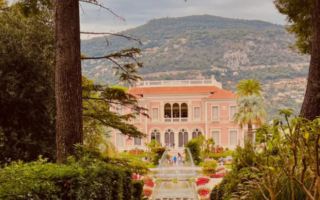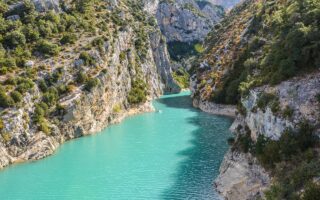A grand day out – Honfleur
It’s never been easier to hop across the Channel and sample France in a day. BEN LERWILL visits Honfleur, while SYLVIE WHEATLEY heads for Cherbourg, CAROLYN BOYD squeezes in the best of Paris and KATE CHAPPELL enjoys Lille
Le Havre isn’t a pretty city, but even at 8am it’s full of life. From the deck of the approaching ferry, the view is a busy one. A foreground of tugboats and bobbing seagulls, then a steady line of headlights rolling past the square buildings on the seafront. On disembarkation, the city is a snapshot of early-morning Normandy: quiet customers in steamy caf�s, dusty Renault hatchbacks at the lights, bus-stop smokers and handshakes all round.
I walk from the port to the Gare Routi�re, supplemented by a coffee and the kind of croissant that makes you wish you’d bought a bagful. It’s an enjoyable way to start the day. I’m here to visit the town of Honfleur, some 20 kilometres up the road, but it won’t be a long visit. I’m catching the 5pm ferry back to Portsmouth and by then I’ll have done some shopping too. The plan is to unwind in Honfleur, indulge in a few hours of exploration, then pick up a nice bottle or ten back in Le Havre. The hope is that fitting travel, culture and supermarkets into a single day doesn’t necessarily mean a rush.
Seductive scene I don’t have to wait long for a bus to Honfleur. The journey takes 25 minutes, and it’s a pleasant trundle. Once the city suburbs have shrunk away, the landscape takes over. Honfleur and Le Havre sit on either side of the Seine estuary and the enormous Pont de Normandie carries vehicles over the river itself. The waters are wide and calm, banked by low woodland and boggy flats. It’s a very bucolic scene. To think of the same river rolling through the finery of Paris, under Pont Neuf and the gargoyles of Notre Dame, seems implausible.
Honfleur is quickly reached then, and the town is sitting pretty in the morning light. Whereas Le Havre is plain and rather dowdy, Honfleur is petite, doe-eyed and seductive. This is somewhere that has welcomed pleasure-trippers for well over a century, and the chief reasons for its popularity are clear; postcard looks and a lively history. There are flowers, fountains and fishing boats, and that’s just by the bus stop. By the time I’ve strolled to the centre, I’ve stopped and stared in half a dozen different places. The town is almost impossibly picturesque.
But whereas today’s appeal lies largely in Honfleur’s quaint architecture and sloping streets, it was its river location that once attracted the eyes of outsiders. Perfectly positioned as a base for the defence of the Seine (which leads, of course, to regional capital Rouen as well as Paris), the medieval town took on huge strategic importance during the Hundred Years War. The English occupied Honfleur twice for brief periods in the mid-1300s, then for a more prolonged spell between 1419 and 1451.
Golden age On its eventual liberation the town was in ruins. It was the workforce of Louis XI that saw to the rebuilding work, bestowing on Honfleur much of its present charm in the process. A golden age followed. By the end of the 15th century the settlement was prosperous on the back of the increase in international maritime trade. A number of significant expedition parties subsequently set sail from the port, most notably that of Samuel de Champlain, who left in 1608 and went on to found Qu�bec.
A memorial stone to de Champlain is one of the many points of interest in the old harbour – le Vieux Bassin – which still forms the centrepiece of modern-day Honfleur. Tall, narrow houses, made all the more alluring by their differing heights and colours, flank the harbour itself. They squeeze up against each other like clubmates in a rugby team photo, tall and small together. I have a pot of tea at a terrace caf� (Le Montpensier, 4 Rue Montpensier, tel: (Fr) 2 31 89 44 30) and gaze up at them. The area to the west of the harbour is ripe for exploration, and I pass a happy morning among the cobbles and timber fa�ades of the backstreets. The red flag of Normandy, two yellow leopards sprawled across its length, hangs above several doorways. Each square and alleyway holds its own architectural quirks and period knickknacks, but most impressive, inevitably, is the Church of Sainte-Catherine, made almost entirely out of wood and resembling less a place of worship than a kind of roaring baronial banqueting hall. It is believed to be the largest wooden church in France and it is beautiful – from its exposed beams to its varnished statuary.
Among the old ramparts and little art galleries, I find a quiet and remarkable museum. The Maisons Satie (67 Boulevard Charles V, tel: (Fr) 2 31 89 11 11 ) are the childhood residence of avantgarde composer Erik Satie, and someone has put a lot of love and attention into turning them into a museum. It is eccentric. There are monocled monkeys, barbed-wire harps and winged pears – and music, of course – and it makes for a memorably offbeat hour. Lunchtime is calling and I settle into a warm restaurant in the backstreets (Le Ch’ti Matelot, 35 Rue Haute, tel: (Fr) 2 31 88 25 64). The menu is tantalising. I plump for moules Pont l’Ev�que, with crusty bread to mop it up and a couple of generous cups of pear cider to wash it down. The cheese pongs in all the right places and the cider leaves a lovely orchardy flavour in the mouth. I don’t want the meal to end, and dawdle over it. A last stroll through town, then an afternoon reverie on the return bus journey. In Le Havre I stock up on the necessary spoils of a French day-trip – plenty of wine, plenty of cheese, cheap even with the pound flailing – then drift back to the ferry. The day has been what I’d hoped for. I watch the Norman coast slip away in the dusk, and spend the crossing gently grappling with today’s Le Monde (note to self: brush up on politics vocab). And improbably, I actually feel quite refreshed. France in a day? It doesn’t have to be a breathless booze cruise.
GETTING THERE: LD Lines operates an overnight service from Portsmouth to Le Havre, leaving Portsmouth nightly at 11pm and arriving into Normandy at 8am. A return ferry leaves Le Havre at 5pm (arriving into Portsmouth at 9.30pm), with an additional service on Sundays to Thursdays leaving at 11pm (arriving into Portsmouth at 6.15am). See www.ldlines.co.uk for further information, and details on alternative sailings.
Office du Tourisme de Honfleur Quai Lepaulmier, 14600, Honfleur Tel: (Fr) 2 31 89 23 30 www.ot-honfleur.fr
Share to: Facebook Twitter LinkedIn Email


